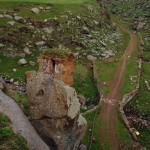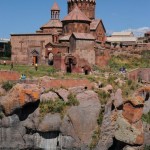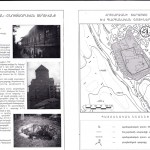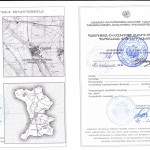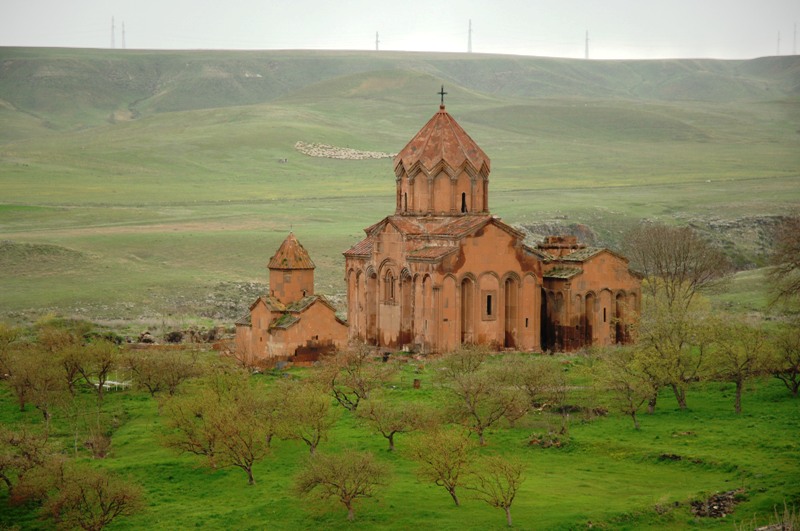THE MONASTIC COMPLEX OF HARITCH
v. Haritch,
state index N 7.63.18.3
This monastic complex, situated in Haritch village, is dated at the VII‒XIII cc. The name of the complex is mentioned for the first time by Mkhitar Anetsi (XIIIc.). The monastic complex of Haritchavank includes St. Grigor and St. Astvatsatsin Churches, built before the XIII c., a library-seminary (semi-ruined) and two chapels. The oldest monuments of the complex are St. Grigor Church and “the Hermit’s Chapel”.
St. Grigor Church — is a construction typical of the VI–VII cc. — central-domed, with a cruciform plan. The church has a rectangular sacristy from the south-east. The church was repaired many times, and, as a result, the dome lost its initial shape.
Later (probably in the XII c.), Sargis Tchon erected the chapel of the 2nd storey on the sacristy attached to the church from the south-west.
St. Astvatsatsin Church — Commander-in-Chief Zakare, buying Haritch and the surrounding land, started the construction of the church at the end of the XII c. According to the construction inscription, the building of the church ended in 1201. At that time the wall was constructed too. A small fragment of the wall, with an arched entrance, has survived in the eastern part of the monastery. The church is a structure belonging to the type of domed halls. The sacristies of the 2nd storey of the western side have been replaced by pillared galleries which appear rarely in the Armenian architecture. The church dome with a fan-shaped calotte has reached a new level of elaboration due to sculpture-decorated rosettes which form a peculiar string-course around the dome. In the artistic decoration of the monument Zakare and Ivane brothers’ church warden bas-relief in the structure of the eastern façade is remarkable.
Narthex — is adjacent to St. Astvatsatsin Church from the west and includes in itself the apse of St. Grigor Church. It had been constructed before 1224, by Prince Vahram Hetchup, and belongs to the type of four-apsidal narthexes.
The second or small narthex — is located on the southern side of St. Grigor Church and was probably built in the XII–XIII cc. From these monuments only the north-western part of the construction has reached us. It has one pillar and by one semi-pillar, adjacent to the northern and western walls.
Library‒seminary — the north-western small fragment of the building of the monastic seminary, belonging to the four-pillared type of narthexes, has survived on the south-eastern side of St. Grigor Church. It was a center of manuscripts writing and miniature painting. Here a series of manuscripts were written and illustrated. The most famous of them are the two manuscripts of 1209 and 1212. The first of them was written and illustrated by scribe Margare.
“Hermit’s Chapel” — is situated in the south-western part of the complex, on a rock fragment. In the course of time it has become detached from the territory, together with the rock fragment, and has bent towards the ravine. It has a rectangular plan, and a vaulted gable roof. Its only entrance is from the north.
It is known from historical sources that Haritchavank was destroyed in the XI c., during Seljuk invasions, and was restored in the XII c., by leader Grigor. Company “Haritch”, established in Gyumri, carried out similar works also in 1850. In 1850‒81 a seminary, cellar-kitchen, dormitory, dining-hall and subsidiary structure were built in the place of the ruined wall, to the north of the monuments group. Later, a 2nd storey was erected on the building of the seminary. It was the Catholicos’s chamber. On the subsidiary structure a seminary was built. In 1883-84 the 2nd arched gate of the complex was built with an adjacent two-storeyed construction. In 1892 a belfry was attached to St. Grigor Church from the east. In 1893 a bridge was built in the ravine which was the end of the company’s construction activity.
During 1995-1999 Haritchavank was partially repaired by the means of Armenian benefactor Eduardo Seferyan from Argentina. In 2005-2006 repair works were realized here, on David Varakyan’s initiative. Nowadays Haritchavank is open. Here repair works have been fulfilled, under the sponsorship of Mother See of Holy Ejmiatsin, since 2010.
The main literature on the monument:
Jalalyan A., The Monument Group of Haritch, “BSS”, 1986, N 2.
Khalpakhchyan O., The Architectural Ensembles of Armenia from the 8th c. B.C. till the 19th c. A.D., Moscow, 1980.





